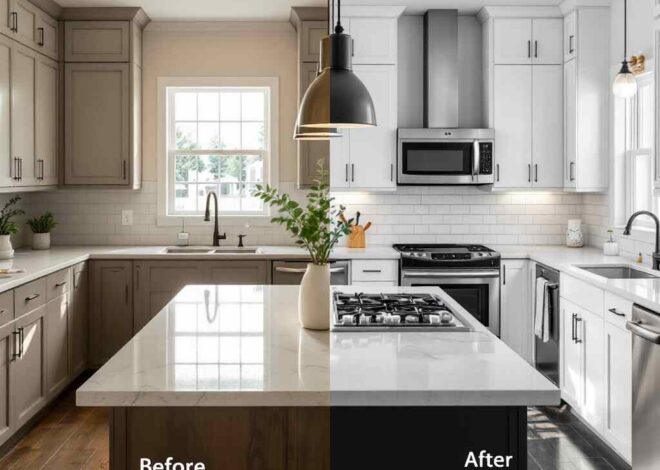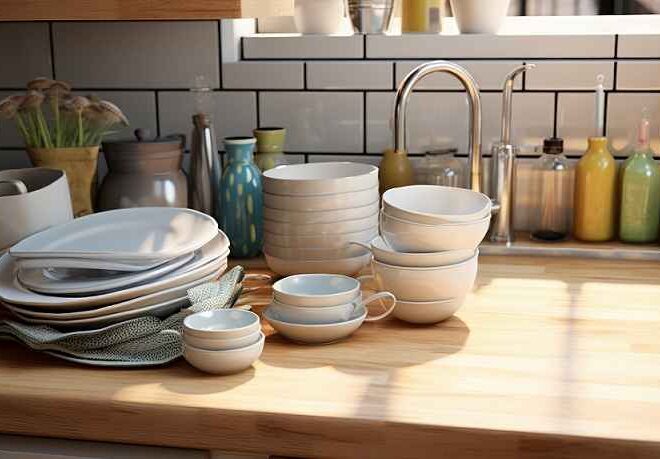
Recaulk Kitchen Counters Like a Pro: A Step-by-Step Guide
Are your kitchen counters starting to look a little worse for wear? Cracks, gaps, and old caulk can not only make your space feel dated but also invite moisture and grime to settle in. Fear not! With a little bit of time and the right tools, you can transform those unsightly edges into smooth, pristine lines that will have your countertops looking as good as new. In this step-by-step guide, “Recaulk Kitchen Counters” we’ll walk you through how to recaulking like a pro—no prior experience required! Whether you’re sprucing up for guests or just want to give your kitchen a fresh facelift, get ready to roll up your sleeves and dive into an easy DIY project that packs a big punch. Let’s get started on rejuvenating those countertops!
Introduction to Recaulking and its Importance in Kitchen Maintenance
Recaulking your kitchen counters might not be the most glamorous task on your to-do list, but it’s essential for maintaining a clean and functional space. Over time, caulk can wear down due to moisture, heat, and general wear and tear. This can lead to unsightly gaps that allow water and grime to seep in, causing potential damage beneath the surface. Not only does a fresh line of caulk enhance the look of your countertops, but it also protects them from mold and mildew growth.
If you’ve ever admired professional-looking finishes in kitchens or wished you could give yours a mini makeover without breaking the bank, you’re in luck! Recaulking is an easy DIY project that anyone can tackle with just a bit of guidance. Get ready to transform your kitchen into a sparkling haven by following this step-by-step guide on how to recaulk kitchen counters like a pro!
Tools and Materials Needed for Recaulking
Before you start the recaulking process, gather your tools and materials to ensure a smooth experience.
You’ll need caulk, of course. Look for silicone or latex varieties suited for kitchen counters. Silicone offers excellent water resistance while latex is easier to clean up.
A caulking gun is essential for applying your chosen product evenly. Choose one with a comfortable grip that allows precise control.
Don’t forget a utility knife or scraper to remove old caulk effectively. A putty knife can also help in smoothing out surfaces after application.
Cleaning supplies are critical as well. Have some rubbing alcohol and paper towels handy to prep the area before you begin.
Lastly, consider having painter’s tape on hand. This will create clean lines and protect surrounding surfaces from unintended messes during application.
Step 1: Preparing the Area for Recaulking
Before diving into the recaulking process, it’s essential to prepare your kitchen counters. This step sets the stage for a smooth application and long-lasting results.
Start by thoroughly cleaning the surfaces. Use a mixture of warm water and mild detergent to remove any dirt, grease, or food particles. A clean area ensures that the new caulk adheres properly.
Next, tackle old caulk removal. Using a utility knife or a caulk remover tool, carefully cut along the edges of the existing caulk. Make sure to extract every bit; any remnants can compromise your new application.
Once you’ve cleared away all traces of old caulking, wipe down the area with rubbing alcohol. This extra step guarantees that everything is pristine and ready for fresh caulk. With these preparations done right, you’ll set yourself up for success in your recaulk kitchen counters project!
-
Cleaning the Counters
Start by clearing the counters of all items. Remove everything from small appliances to decorative pieces. This creates a clean slate for your recaulk kitchen counters project.
Next, grab a quality surface cleaner or a mixture of warm water and mild dish soap. Wipe down the surfaces thoroughly. Focus on areas around seams where grime tends to accumulate.
For tougher stains, consider using a soft scrub brush or sponge. Avoid anything abrasive that could scratch your countertop surfaces.
Rinse with clean water to ensure no residue remains, then dry everything completely with a microfiber cloth. A dry surface is key for effective caulking later on.
Taking this time ensures that you’re starting fresh and ready for the next steps in your recaulk kitchen counters journey.
-
Removing Old Caulk
Removing old caulk can be a bit tricky, but it’s essential for a seamless finish. Start by cleaning the surface thoroughly with a utility knife or a caulk removal tool to remove any loose debris or old caulk. Gently slide the blade under the existing caulk to lift it away from the surface.
Take your time during this step; rushing may damage the countertop material underneath. If you encounter stubborn bits, try scoring them lightly with your knife before pulling them up.
Once most of the caulk is removed, check for any residue left behind. A plastic scraper can help get rid of that last little bit without scratching your counters.
Don’t forget to clean the area thoroughly afterward. Use rubbing alcohol or an appropriate cleaner to eliminate all debris and oils. A well-prepared surface makes all the difference in how effectively new caulk adheres!
Step 2: Choosing the Right Caulk for Your Kitchen Counters
Selecting the appropriate caulk for your kitchen counters is essential. The type of caulk can significantly affect durability and appearance.
Look for products specifically designed for kitchens and bathrooms. These options often contain antimicrobial agents that resist mold and mildew, making them ideal for areas prone to moisture.
Silicone caulk is a popular choice due to its flexibility and water resistance. It adheres well to various surfaces like granite, quartz, or laminate.
If you prefer paintable surfaces, opt for acrylic latex caulk. This option allows you to match your countertop color seamlessly after application.
Consider the cure time as well; some caulks dry faster than others. Selecting one with quick curing properties can save you time during the project.
Read labels carefully to ensure you’re getting exactly what fits your needs in terms of performance and aesthetic appeal.
Step 3: Applying the Caulk
Applying the caulk is where your skills truly shine. Begin by slicing the tip of the caulk tube at a 45-degree angle. This helps control the flow and gives you precision.
Squeeze gently as you move along the seam. Aim for an even bead that fills the gap without overflowing. If you’re working with corners, take extra care to keep it neat; corners can be tricky but are essential for a polished look.
For those stubborn gaps, consider using a backer rod before applying caulk. It provides support and prevents sagging.
Don’t rush this step—patience pays off here. A steady hand makes all the difference in achieving that professional finish everyone admires when they walk into your kitchen.
-
Techniques for a Smooth Application
Achieving a smooth application of caulk is essential for a professional finish. Start by using a steady hand when applying the caulk. This ensures an even bead that adheres well.
Consider using painter’s tape along the edges where you’ll be applying caulk. It helps create clean lines and prevents any mess on surrounding surfaces.
While applying, hold the tube at about a 45-degree angle. Move it slowly to maintain consistent pressure and flow.
If you prefer, use your finger or a damp cloth to smooth out the caulk after application. This technique allows for better blending into corners and gaps.
Don’t rush this step; take your time to get it right. A little patience goes a long way in achieving that sleek look you desire for your kitchen counters.
-
Dealing with Corners and Gaps
Corners and gaps can be a challenge when you recaulk kitchen counters. They often require extra attention to ensure a seamless finish.
Start by applying the caulk into the corner gently, allowing it to fill any spaces without pushing too hard. This helps prevent excess from oozing out.
For tight corners, use your finger or a small tool to push the caulk deeper into the gap. This creates an even seal that keeps water and debris at bay.
If you’re working with countertops that meet walls or backsplashes, take care not to overfill. Too much caulk in these areas can lead to unsightly bulges.
After you’ve filled the gaps, smooth everything out carefully for a professional look. The key is patience; taking time here will pay off with durability and aesthetics later on.
Step 4: Smoothing and Finishing Touches
After applying the caulk, it’s time to focus on smoothing and finishing touches. A caulk smoother or a simple finger can work wonders here. Lightly run your tool along the bead of caulk for an even finish.
If you’re using your finger, dampen it slightly with water and glide it over the caulked area. This technique will help create a clean line without excess buildup.
Next, carefully remove any excess caulk that might have squeezed out during application. A sharp utility knife works well for this task; just be cautious not to damage surrounding surfaces.
Lastly, allowing sufficient drying time is crucial. Each type of caulk has its own drying period, so check the manufacturer’s instructions before you touch or use the counters again. Following these steps ensures a polished look that enhances both functionality and aesthetics in your kitchen space.
-
Using a Caulk Smoother or Tool
Using a caulk smoother or tool can elevate your recaulk kitchen counters to a professional level. These tools are designed to create clean lines and an even finish, making your work look polished.
To use one effectively, glide the smoother along the bead of caulk you just applied. Apply gentle pressure as you move it, ensuring that the caulk spreads evenly into the crevices. This technique helps eliminate any excess while filling gaps seamlessly.
If you don’t have a commercial tool on hand, consider using your finger with some water for lubrication. Just remember to keep it steady and apply consistent pressure for optimal results.
Cleaning the smoother after each pass is essential too; this prevents build-up which could ruin your final appearance. A little attention during this step pays off big time in achieving that flawless finish everyone desires.
-
Removing Excess Caulk
Once you’ve applied your caulk, it’s essential to tidy up any excess. This not only enhances the appearance but also prevents future issues.
Use a damp cloth or sponge to gently wipe away stray beads of caulk while it’s still wet. Don’t press too hard; you want to avoid disturbing the smooth line you’ve just created.
If there are stubborn bits that have dried, grab a utility knife for precision. Be careful as you scrape along the edges—aiming for clean lines without damaging your counters.
For truly tricky spots, rubbing alcohol on a paper towel can help dissolve leftover residue. Just remember to test in an inconspicuous area first to ensure no damage occurs.
Taking these steps will elevate your recaulking project from average to professional-looking with minimal effort.
-
Letting it Dry Properly
After applying your new caulk, patience is key. Allowing it to dry properly ensures a strong bond and protects against moisture damage.
Typically, most caulks require at least 24 hours to fully cure. Check the manufacturer’s instructions for specific drying times. This will give you an idea of how long you need to avoid using the counters.
Keep the area well-ventilated during this time. Good airflow can help speed up the drying process, but avoid direct drafts that might disturb the fresh application.
Avoid touching or cleaning around the newly caulked area until it’s completely set. Premature contact can lead to smudges or uneven surfaces.
Taking these steps will result in a neat finish that looks professionally done and stands up better over time.
Tips and Tricks for a Professional-Looking Finish
Achieving a professional-looking finish when you recaulk kitchen counters is all in the details. Here are some handy tips and tricks to elevate your DIY project.
Start by selecting a high-quality caulk for optimal results. Silicone caulks are popular due to their durability and flexibility, but polyurethane options also work well, especially in kitchens. Be sure to choose a color that matches or complements your countertops for a seamless appearance.
When applying the caulk, use steady pressure on the tube trigger to create an even bead. Move slowly and maintain consistency throughout the application process; this will help prevent gaps or uneven areas. If you’re dealing with corners or tight spots, consider using painter’s tape along edges to ensure crisp lines.
Once you’ve applied the caulk, grab a smoothing tool or simply use your finger dipped in water for smoothing out any rough patches. This extra step can make all the difference in achieving that polished look you desire.
After removing excess caulk carefully—without disturbing what’s already applied—allow it ample time to dry as per product instructions before exposing it to moisture. Patience pays off here!
Remember these tips next time you tackle recaulking your kitchen counters. You’ll not only protect them from damage but also enhance their overall aesthetic appeal! With practice and attention to detail, you’ll become quite skilled at this essential home maintenance task.


